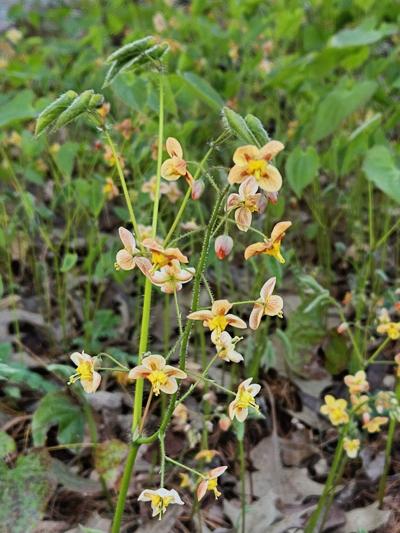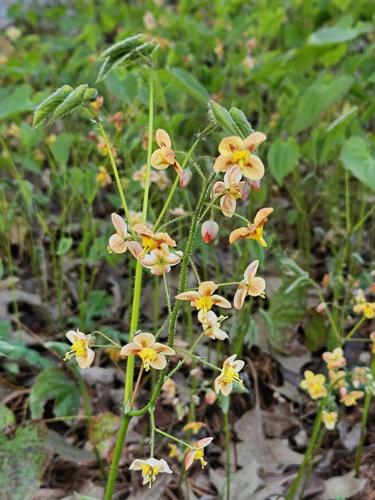The No. 1 complaint of those who are relegated to gardening under the cover of trees, where the soil is dry and blooms are scarce, is that there’s not much more to choose from beyond hostas, heucheras, ferns or periwinkle.
Although those plants will continue to be shady staples, there is another plant that is finally getting some mainstream recognition. Epimediums are showing up in specialty catalogues, local garden centers and in people’s gardens.
Epimediums are among the better suggestions for planting in dry shade. They thrive in it in fact. I have them planted in the toughest spots we have, beneath a spreading, 50-year-old lacebark elm. Many varieties colonize quickly, and the foliage holds up very well throughout the summer so they can be considered a reliable ground cover in addition to their early spring blooms (now) and glossy mottled green foliage (throughout the summer). In addition, many varieties will remain evergreen throughout the winter in zone 6.
The flowers are dainty, orchid-like flowers (also reminding me of more finely-cut columbine blossoms) that rise above the foliage in the spring of the year. The rosy flowers of epimedium x rubrum are complimented by the new, light green spring foliage, set off by red leaf margins and mottling. As the foliage ages, it takes on a deeper, solid green color. This one is semi-evergreen, and the old foliage should be trimmed up in early spring to make room for new growth and allow the blooms to be seen at their best.
Frohnleiten is a cultivar that is perfect for the woodland garden, because it spreads about 6-8 inches each year, with some varieties spreading more slowly. The foliage is mottled red in early spring. The blooms are a buttery yellow, and the evergreen foliage takes on a green, glossy quality as spring turns to summer.
Those that are exceptional for their flowers, according to epimedium specialist Darrell Probst, include many of the epimedium grandiflorium cultivars. The flower colors range from rosy pink, to yellow to crimson. For example, the large, translucent white blooms of e. x grandiflorum ‘Bandit’ are set off in the spring by its chartreuse foliage with deep purple margins. My favorite remains ‘Orange Queen’ because it spreads fast and has solved so many of my dry shade problems in short order!
Epimediums are typically easy to grow because they are not finicky about their growing environment. Dappled shade, with rich, well-drained soil is the ideal for maintaining large, colorful foliage and maximizing the number of blooms. They will really take off if they have an agreeable environment. However, most epimedium growers choose to locate their plants in less-than-ideal conditions, because they outperform everything else.
Most species prove to be quite content in clay soil, under dry conditions. Not too much seems to bother them, but don’t be surprised if you see some slug activity (which is barely noticeable).
So, if you see epimediums for sale at your favorite local nursery, snatch them up for your garden. You will be delighted by their appearance and performance next spring when the new foliage replaces the old, and when the dainty, orchid-like blooms emerge above colorful foliage.






(0) comments
Welcome to the discussion.
Log In
Keep it Clean. Please avoid obscene, vulgar, lewd, racist or sexually-oriented language.
PLEASE TURN OFF YOUR CAPS LOCK.
Don't Threaten. Threats of harming another person will not be tolerated.
Be Truthful. Don't knowingly lie about anyone or anything.
Be Nice. No racism, sexism or any sort of -ism that is degrading to another person.
Be Proactive. Use the 'Report' link on each comment to let us know of abusive posts.
Share with Us. We'd love to hear eyewitness accounts, the history behind an article.